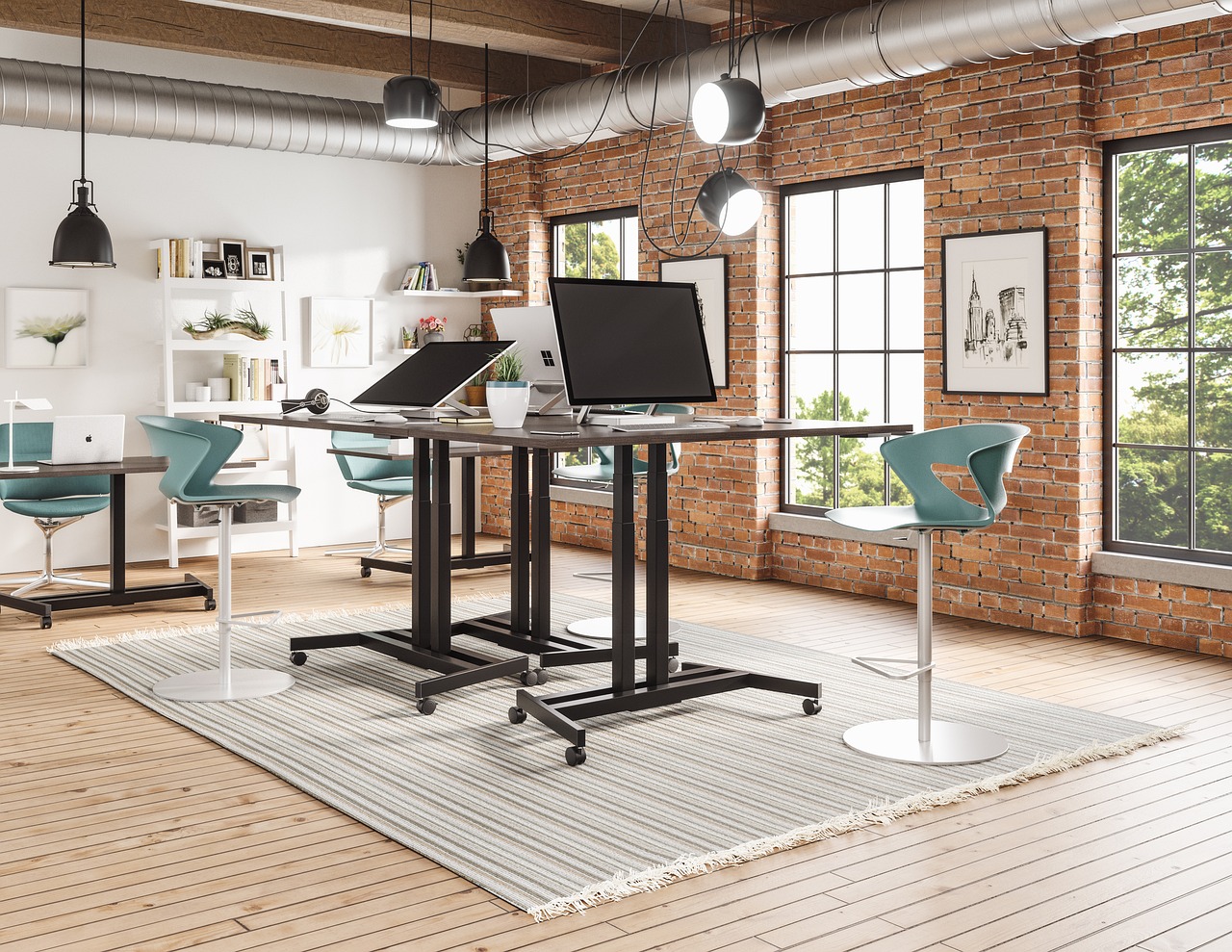
Creating a comfortable home workspace is essential for maintaining productivity and overall well-being. In this article, we will explore the science of ergonomics and its importance in designing a workspace that promotes good posture, reduces discomfort, and enhances efficiency. By understanding the principles of ergonomics, you can transform your home office into a haven of comfort and productivity.
Benefits of Ergonomics in a Home Workspace
Creating an ergonomic home workspace has numerous benefits that can greatly enhance your overall well-being and productivity. By considering the principles of ergonomics in the design and setup of your workspace, you can experience increased productivity, reduced risk of musculoskeletal disorders, and improved overall well-being.
Increased productivity
When your workspace is ergonomically designed, you are able to work more efficiently and effectively. Ergonomics focuses on optimizing your physical and mental comfort, allowing you to concentrate and complete tasks with greater focus and ease. By reducing physical discomfort and strain, you can devote more energy to your work, resulting in increased productivity.
Reduced risk of musculoskeletal disorders
One of the key benefits of ergonomics in a home workspace is the prevention of musculoskeletal disorders. These disorders, such as back pain, neck strain, and carpal tunnel syndrome, can be caused by prolonged periods of poor posture or repetitive movements. By incorporating ergonomic principles into your workspace design, you can reduce the risk of developing these conditions, as well as alleviate any existing discomfort or pain.
Improved overall well-being
An ergonomic home workspace promotes overall well-being by prioritizing your physical health and comfort. By maintaining proper posture, positioning your body correctly, and incorporating movement into your routine, you can reduce the risk of physical ailments and improve your overall quality of life. Additionally, an ergonomically designed workspace can contribute to better mental health, as it allows you to work in a comfortable and stress-free environment.
Choosing the Right Furniture
When it comes to creating an ergonomic home workspace, selecting the right furniture is crucial. Here are some key features to consider when choosing furniture for your workspace.
Ergonomic desk and chair
Investing in an ergonomic desk and chair is paramount to creating a comfortable and supportive workspace. Look for furniture that is adjustable and allows you to customize the height and positioning to suit your body. Ergonomic chairs should have a supportive backrest and armrests, while ergonomic desks should provide ample space for your work materials and allow for proper positioning of your monitor and keyboard.
Adjustable height options
Adjustable height options are essential for an ergonomic workspace, as they allow you to find the perfect height for your desk and chair. Being able to adjust the height ensures that you maintain the proper posture and alignment, reducing strain on your neck, back, and wrists.
Supportive backrest and armrests
A supportive backrest and armrests are essential features of an ergonomic chair. The backrest should provide proper lumbar support, promoting a neutral spine position, while the armrests should allow your arms to rest comfortably without straining your shoulders or wrists. Look for chairs that offer adjustable backrest and armrest options to cater to your individual needs.

Optimizing Lighting
Proper lighting is an often overlooked aspect of creating an ergonomic home workspace. By optimizing the lighting in your workspace, you can reduce eyestrain, improve focus, and create a more comfortable environment.
Natural light considerations
Whenever possible, incorporate natural light into your workspace. Natural light provides a balanced and pleasant lighting environment, reducing eye fatigue and positively impacting your mood. Position your desk near a window or use curtains that allow sunlight to filter through while preventing glare on your computer screen.
Proper task lighting
In addition to natural light, ensure you have proper task lighting for your workspace. Task lighting should be directed towards your work area and provide adequate illumination without causing glare. Consider using adjustable desk lamps or LED lights that can be positioned to suit your needs and reduce eyestrain.
Reducing glare and eyestrain
Glare on computer screens can be a major source of eyestrain and discomfort. To reduce glare, position your monitor perpendicular to any windows or light sources. If glare persists, consider using an anti-glare screen filter or adjusting the screen settings to reduce brightness and contrast. Additionally, take regular breaks to rest your eyes and focus on objects at varying distances to reduce eye fatigue.
Setting Up an Ergonomic Desk
The setup of your desk plays a crucial role in promoting proper posture and reducing the risk of strain-related injuries. Consider the following tips to ensure your desk is ergonomically optimized.
Placement of monitor
Position your monitor directly in front of you at eye level. The top of the monitor should be at or slightly below eye level, allowing you to maintain a neutral neck position. If necessary, use an adjustable monitor stand or stack books underneath to achieve the proper height. Avoid placing the monitor off to the side or too low, as this can cause neck and eye strain.
Keyboard and mouse positioning
Position your keyboard and mouse so that your elbows are at a 90-degree angle and your forearms are parallel to the ground. This helps to prevent wrist strain and allows for proper blood circulation. Your keyboard should be placed directly in front of you, and the mouse should be within easy reach, preferably at the same level as the keyboard. Consider using a wrist rest to support your wrists and alleviate strain.
Organizing and decluttering
Keeping your desk organized and free of clutter is an important aspect of creating an ergonomic workspace. Remove any unnecessary items from your desk and keep only the essentials within reach. Utilize desk organizers, cable management solutions, and storage options to maintain an organized and tidy workspace. A clutter-free desk promotes a clear and focused mind, leading to increased productivity and reduced stress.

Addressing Posture and Body Alignment
Maintaining proper posture and body alignment is essential for a healthy and comfortable home workspace. Incorporate the following practices into your routine to ensure optimal posture and reduce the risk of strain-related injuries.
Maintaining a neutral spine
Proper alignment of your spine is key to preventing back and neck pain. Sit with your back fully supported by the chair’s backrest, ensuring that your natural spinal curves are maintained. Avoid slouching or leaning forward, as this can strain the muscles in your back and neck. Consider using a lumbar support pillow or an ergonomic chair with built-in lumbar support to help maintain proper spinal alignment.
Proper positioning of wrists and arms
When using your keyboard and mouse, keep your wrists in a neutral position. Your wrists should be straight and level, not bent upward or downward. Avoid resting your wrists on hard surfaces, as this can compress the nerves and lead to discomfort. Consider using a wrist rest or an ergonomic keyboard and mouse that promote a natural and comfortable hand position.
Avoiding prolonged sitting
Sitting for extended periods can lead to a variety of health issues, including back pain, muscle stiffness, and decreased circulation. Combat these negative effects by incorporating regular movement into your routine. Take short breaks every 30 minutes to stand up, stretch, and walk around, allowing your muscles to relax and providing a temporary relief from sitting. Consider investing in a standing desk or a height-adjustable desk that allows you to switch between sitting and standing positions throughout the day.
Supporting Leg and Foot Health
While much attention is given to the upper body when creating an ergonomic workspace, it is equally important to address leg and foot health. By considering the following tips, you can optimize your leg and foot comfort while working.
Choosing an ergonomic footrest
Using a footrest can help alleviate pressure on your legs, feet, and lower back. Look for a footrest that is adjustable in height and angle, allowing you to find the perfect position for your feet. A footrest can promote healthy circulation and reduce swelling, minimizing the risk of leg fatigue and discomfort.
Alternating between sitting and standing
Sitting for prolonged periods can place excessive pressure on your legs and feet. To alleviate this pressure, alternate between sitting and standing throughout the day. Invest in a standing desk or a height-adjustable desk that allows you to switch between sitting and standing positions easily. Standing allows your legs to bear your body weight, promoting blood circulation and reducing the risk of leg-related issues.
Stretching and moving regularly
Incorporating regular stretches and movements into your work routine can help prevent leg cramps, fatigue, and stiffness. Take short breaks every hour to stretch your legs and engage in light exercises such as calf raises, ankle rotations, or leg stretches. Simple movements like these can improve blood circulation, loosen tight muscles, and keep your legs and feet feeling energized throughout the day.

Enhancing Comfort and Air Quality
Creating a comfortable and healthy workspace goes beyond furniture and lighting considerations. By focusing on comfort and air quality, you can further optimize your home workspace experience.
Using ergonomic accessories
Ergonomic accessories can enhance your comfort and support while working. Consider investing in an ergonomic mouse pad, wrist rest, or a document holder to provide additional support and reduce strain on your body. These accessories are designed to promote proper alignment and alleviate discomfort during long work hours.
Selecting a suitable chair cushion
If your chair does not provide sufficient cushioning or support, consider using a seat cushion to increase your comfort. Look for cushions that are specifically designed for prolonged sitting and provide adequate support for your buttocks and thighs. A cushion with memory foam or gel padding can help distribute your body weight evenly and reduce pressure points, preventing discomfort and promoting better posture.
Improving indoor air quality
Indoor air quality can greatly affect your comfort and overall well-being. Ensure that your workspace is well-ventilated and free from pollutants. Open windows regularly to allow fresh air to circulate, or use an air purifier to filter out dust, allergens, and other irritants. Additionally, keep your workspace clean and free from dust and clutter to minimize allergens and promote a healthier environment.
Optimizing Technology Use
In today’s digital age, technology plays a significant role in our work lives. Optimizing technology use in your home workspace can help minimize strain and enhance your comfort.
Adjusting monitor height and angle
Proper monitor positioning is crucial for reducing strain on your neck and eyes. Adjust the height of your monitor so that the top of the screen is at or slightly below eye level. Tilt the screen slightly backward to reduce glare. Consider using a monitor stand or adjustable arm mount to achieve the desired height and angle. Additionally, position the monitor at arm’s length away from you to reduce eye strain.
Using ergonomic keyboard and mouse
Traditional keyboards and mice can often cause discomfort and strain during prolonged use. Consider investing in an ergonomic keyboard and mouse that are designed to promote natural hand and wrist positioning. Ergonomic keyboards are typically split into two sections and have a slight incline, allowing for a more relaxed hand and wrist position. An ergonomic mouse is designed to fit the natural contours of your hand, reducing strain and pressure.
Reducing screen time
Excessive screen time can lead to eye strain, fatigue, and decreased productivity. To optimize technology use, take regular breaks from your screen. Follow the 20-20-20 rule, which suggests looking at something 20 feet away for 20 seconds every 20 minutes. This practice helps reduce eye strain by giving your eyes a chance to refocus and relax. Additionally, consider incorporating screen-free activities, such as reading a physical book or taking a short walk, into your daily routine to give your eyes and mind a break.

Incorporating Movement and Exercise
Sedentary behavior can have detrimental effects on your health and overall well-being. By incorporating movement and exercise into your daily routine, you can counteract the negative effects of prolonged sitting and promote your physical and mental well-being.
Implementing a standing desk
Standing desks have gained popularity due to their numerous health benefits. Using a standing desk allows you to switch between sitting and standing positions while working. Standing encourages movement, improves blood circulation, and engages your muscles, reducing the risk of prolonged sitting-related health issues. Start by standing for short periods and gradually increase the duration over time.
Performing ergonomic exercises
Ergonomic exercises are specifically designed to stretch and strengthen the muscles affected by sedentary work. Incorporate simple exercises, such as neck and shoulder stretches, wrist rotations, or back extensions, into your work routine. These exercises help relieve muscle tension, improve flexibility, and promote a healthier posture. Set reminders or use fitness apps to ensure you take regular breaks for exercise.
Taking regular breaks
Taking regular breaks from your work and incorporating movement throughout the day is essential for your overall well-being. Stand up, stretch, and walk around every 30 minutes to alleviate muscle tension, increase blood flow, and give your mind a refresh. Consider using a timer or a productivity app that reminds you to take breaks and encourages physical activity. Taking care of your physical health through regular movement and exercise can significantly contribute to your productivity and overall well-being.
Creating a Wellness Routine
In addition to the physical aspects of ergonomics, it is important to consider your mental and emotional well-being when designing your home workspace.
Practicing mindfulness and stress management
Working from home can blur the boundaries between work and personal life, potentially leading to increased stress and burnout. Incorporate mindfulness and stress management techniques into your daily routine to promote a healthier work-life balance. Practice deep breathing exercises, meditation, or yoga to reduce stress and improve focus. Set boundaries between work and personal time, and establish a dedicated routine that allows for relaxation and self-care.
Designating a dedicated workspace
Creating a designated workspace in your home helps establish a clear boundary between work and personal life. Designate a specific area solely for work, preferably separate from your living or sleeping areas. This dedicated space sets the tone for productivity and allows you to mentally shift into work mode when you enter the workspace. By creating a physical separation, you can better balance your work responsibilities and personal life.
Ergonomic tips for remote work
If you work remotely, ergonomics becomes even more important, as you are responsible for creating a comfortable workspace without the support of a dedicated office environment. Apply all the previously mentioned ergonomic tips to your home workspace and consider investing in portable ergonomic accessories, such as a laptop stand, an adjustable keyboard tray, or a portable lumbar support cushion. These items can help you maintain proper posture and comfort, regardless of where you choose to work.
By incorporating these ergonomic principles and practices into your home workspace, you can create a comfortable, healthy, and productive environment. Remember, the key is to prioritize your physical and mental well-being, and to make adjustments and adaptations that suit your individual needs. So, take the time to create a workspace that supports your body and mind, and enjoy the benefits of an ergonomically optimized home workspace.

